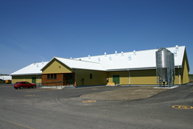Poultry research gets cracking

Courtesy HCR Photo
Things are looking sunny side up for the new McGill University Centre for Poultry Research on the Macdonald Campus in Ste. Anne de Bellevue. After three years of construction, the centre is set to officially throw open its doors on May 26. In collaboration with the Université de Montréal's School of Veterinarian Science in Saint Hyacinthe, the Centre of Poultry Research will focus on nutrition, physiology, genetics and management in relation to safety and quality. Both research centres will also look at ways to reduce the use of antibiotics and medications and bacterial contamination.
The collaboration between the two institutions was hatched when the Université de Montréal's Martine Boulianne and McGill's now-retired Roger Buckland agreed on the common need to upgrade McGill's three poultry centre buildings —one of which was built in 1906 — and bring together the expertise of both universities. The idea took flight in the Fall of 1998 and is now a landed reality in the Spring of 2005. The $7.5 million project would not have been possible withtou the participation and funding from both the public and private sectors. The Canada Foundation for Innovation (CFI) and the Quebec government contributed $4.22 million. Another $3 million came from the private sector, including — appropriately enough — Rotisseries St. Hubert ($300,000), Cara Foods ($500,000), the Chicken Farmers of Canada ($200,000) and the Fédération des producteurs de volailles du Québec ($250,000).
Poultry is big business in Canada, with almost 50,000 jobs associated with various aspects of the industry, contributing close to $9.5 billion to the economy. It is the goal of the Macdonald researchers to protect the investment: the laying chickens, broiler chickens and turkeys that eventually find their way into our stores and onto our tables.
Newly arrived via Mexico, Texas, Arkansas and Tennessee, McGill's Ciro Ruiz came to the Centre for Poultry Research with expertise in the field of nutrition and physiology of chickens. His role in chicken research is aimed at improving their cardiopulmonary function, a factor that can contribute up to a 5 percent mortality rate in the birds. Ruiz is investigating the use of lignin, a component of the cell wall of plants, as an alternative to conventional antibiotics.
"The cardiopulmonary problem comes from the broiler chicken growing too fast," said Ruiz. "Whereas 30 years ago, it used to take 16 weeks to get the broiler to market, it now takes only 6 weeks, or 42 days for a two-kilo chicken." Ruiz will be working on his project for the next two years, confident that the new McGill facility's capacity will aid in the field of alternative antibiotics.
For molecular biologist Urs Kuhnlein, the new research centre means all his work can be done locally. Although he will continue his association with Agriculture Canada and the University of Guelph, the new facilities will give him more autonomy. Kuhnlein's focus is on Marek's Disease (MD), which is a strain of the herpes virus that affects young layers (six to 16 weeks of age), causing tumours that can result in a 60 percent mortality rate. The economic impact of MD on the world poultry industry is estimated to be around $1 to 2 billion (U.S.). "New vaccines are being developed but new viruses are more virulent, and they become resistant to vaccines," said Kuhnlein. Chickens are particularly vulnerable to MD right after hatching, and Kuhnlein is looking at what mechanisms are at work in disease resistance.
"We have all the tools available to understand the biology of the chicken, including genotyping. But certain other conditions are not controlled, like the need to strike a balance between cost and return," he said, adding that conditions for raising chickens may not always take into account the health of the animal. Kuhnlein's efforts will be aided by state-of-the-art facilities that will house Canada's only level-two disease contaminant facility dedicated to poultry research.
Lest we forget that oft-neglected, once-a-year visitor to our dinner tables, the turkey: molecular endocrinologist David Zadworny is taking care of that high-maintenance fowl (turkeys cost more to raise than chickens). Female turkeys, even when domesticated, retain some of their wild instincts, which include the nurturing/nesting instinct; in a commercial setting this tends to slow down production. "My area of interest is the biology of maternal instincts," said Zadworny. "It's not necessarily a priority to increase production, but a turkey will stop eating and drinking while incubating its eggs. My research is to question how that behaviour can be modified."
The pituitary hormone prolactin (PRL) has long been associated with the expression of incubation behaviour. Blood levels of PRL increase six- to 10-fold at the onset of reproductive behaviour. "Our studies have concentrated on understanding the roles of PRL and its receptors in avian reproduction at the DNA, RNA and protein levels," said Zadworny. "A greater understanding of the endocrinology may provide development of new therapeutic methods for selection against this economically important trait."

Courtesy Hans Larsson

Nancy Lacigne
At Redpath Museum, vertebrate paleontologist Hans Larsson studies egg embryos supplied by the Centre for Poultry Research. Larsson's lab focuses on the relationship between micro-evolutionary changes to vertebrate skeletons and what developmental mechanisms may be responsible for these changes. Long the mainstay of embryological studies, the chicken embryo yields insight into the rich ancestry of bird skeleton evolution. Larsson and his six assistants address topics like fish fin to tetrapod limb transition and finger reduction in the bird ancestry of carnivorous dinosaurs as well as anatomical development and evolution of a broad sampling of birds and crocodiles.
